
pre-1900 : 1900 and later

pre-1900
: 1900 and later
*(S
Rating) Scarcity Rating (includes scarcity, relevance and content) - with 10
being the most desirable and 1 easiest to acquire. Those highlighted in the
deeper shades of red are highly sought after works.

 Contenant des observations sur la géologie, la géographie, l'histoire naturelle de ce continent, et une esquisse du caractère physique et moral des diverses races d'habitans qui environnent l'Etablissement du Cap de Bonne-Espérance.
Contenant des observations sur la géologie, la géographie, l'histoire naturelle de ce continent, et une esquisse du caractère physique et moral des diverses races d'habitans qui environnent l'Etablissement du Cap de Bonne-Espérance.
Suivi de la description de l'état présent, de la population, et du produit de cette importante Colonie.
2 volumes, I. xvi, 403, (i Tables des chapitres). II. 326, (ii Table des chapitres & errata), large folding map at the end of volume II with Barrow's journeys indicated in yellow, folding table of the useful woods of the colony, 1 engraved plate, contemporary quarter brown leather with marbled paper sides, joints strengthened with clear tape, the leather and marbled paper are rubbed, bookplates on front paste-down endpapers, contents good complete with the half title pages.
These books cover Barrow's trip to South Africa (1797-98)
See also English version: An Account of Travels into the Interior of Southern Africa
The Balson Holdings Family Trust holds a copy of this first edition book in good condition (and the 1969 reprint).
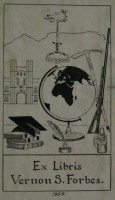
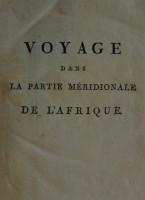
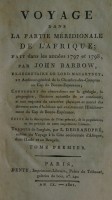
Critical comment on this work:Fabulous early account of South Africa. |

 This rare 320 page original first edition hardcopy book
is entitled "Exhibiting a
Faithful and Correct View of the Manners and Customs of the Inhabitants of the
Cape of Good Hope and Surrounding Country. With a full and comprehensive Account
of the System of Agriculture adopted by the Colonists: Soil, Climate, Natural
Productions, &c. &c. &c., interspersed with observations and
reflections on the STATE OF SLAVERY in the Southern Extremity of the African
Continent. In a series of letters from an English Officer during the Period in
which that Colony was under the protection of the British Government.
Illustrated with Engravings."
This rare 320 page original first edition hardcopy book
is entitled "Exhibiting a
Faithful and Correct View of the Manners and Customs of the Inhabitants of the
Cape of Good Hope and Surrounding Country. With a full and comprehensive Account
of the System of Agriculture adopted by the Colonists: Soil, Climate, Natural
Productions, &c. &c. &c., interspersed with observations and
reflections on the STATE OF SLAVERY in the Southern Extremity of the African
Continent. In a series of letters from an English Officer during the Period in
which that Colony was under the protection of the British Government.
Illustrated with Engravings."
An account of the Cape of Good Hope before the Batavian Republic. An anonymous British officer, the writer of this series of 39 letters, was evidently a strong opponent of slavery, and a large part of the work is devoted to both his views on the matter, and a sketch of the various forms of slavery that have existed from ancient times.
Contains ten great full-page engravings. Rebound in a new hardback cover (see scans). Front and rear hinges slightly darkened in gutter due to darkening of binding glue over time, this is quite minor. No dust jacket (none was issued.)
A valuable reference work.
The Balson Holdings Family Trust holds a copy of this first edition book in very good condition (and the 1969 reprint).
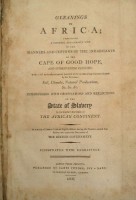 |
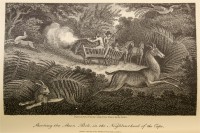 | |
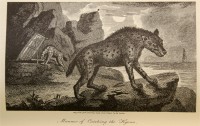 |
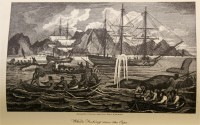 |
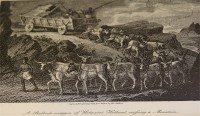 |
Critical comment on this work:Excellent reference book - detailing how poorly the indigenous Hottentot people were treated. |
 Burchell and Latrobe - Book Review
Burchell and Latrobe - Book ReviewThe 43 page rebound review has been removed from a larger review book and rebound in soft blue covers. The review covers several books including Burchell's "Hints on Emigration to the Cape"; Latrobe's "Journal of a visit to South Africa"; and Richard Fisher's "The Importance of the Cape of of Good Hope".
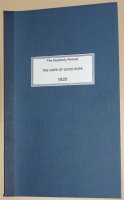 Conflicting
views are aired, some bordering on outrageous others openly racist.
Conflicting
views are aired, some bordering on outrageous others openly racist.
For example, the review states: "How many hundreds or thousands of years previously to the arrival of these Europeans the poor Hottentots remained dumb, Mr Fisher does not condescend to inform us; but as he obligingly instructs us that "the garrulity of the magpie, the solemn hooting of the owl, the chattering of the daw, and the cackling of the goose," are "sounds of a language" in which all these features have a prodigious advantage over the Hottentot, who could neither speak nor cackle, hoot nor chatter, it is manifest in what rank of the animal creation he means to place them."
The views of Burchell and Latrobe are far more understanding and balanced as they relate to the Hottentot.
The Review also makes this stunning admission on land ownership and the manner in which land had been stolen from the Hottentots (p 221): "By degrees the agents who carried on a barter with the simple nation, found their advantage in breeding cattle themselves; and finally, by means of spirits and tobacco, they contrived not only to juggle the Hottentots out of the whole of their flocks but to compel them to take care of them. The (Dutch East India) Company, placing no value on the land, particularly such parts as lay behind the mountains, dealt it out to those graziers with a liberal hand; tracts of about 5000 acres each were granted in perpetual leasehold, on an annual payment of 24 rix-dollars or about five pounds sterling, something less than a farthing an acre. The person desirous of obtaining one of these loan-farms, as they were called, having pitched upon an unoccupied spot, erected a baaken, or land mark on the most convenient spot from which, as from a centre, all the lands that fell within the periphery of a circle whose radius was half an hour's walk, or one mile and a half, was considered as comprized in the grant.... Thus removed from the seat of authority, and placed where no one was near enough to see, much less control his actions, the Vee-boor lorded it over the kraal of Hottentots with the undisputed power of a feudal chief, from whose tyranny they had no appeal."
The Balson Holdings Family Trust holds a copy of this text in excellent condition rebound in soft blue covers.
Critical comment on this work:Fascinating review which demonstrates the conflicting views of early settlers and explorers when it came to their description and immoral dealings with the Hottentots. |
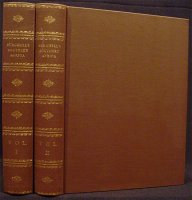 Travels in the interior of South Africa - William J
Burchell 1822/24 - 1967 Reprint
Travels in the interior of South Africa - William J
Burchell 1822/24 - 1967 Reprint  This is a
limited/numbered reprint, No. 408 of 1000.
This is a
limited/numbered reprint, No. 408 of 1000.
Contains frontispiece portrait of Burchell, plus 18 colour plates by Burchell and numerous b/w line drawings throughout. Fold-out map of the Extra-tropical part of Southern Africa. Both volumes are in perfect condition.
The original book is extremely rare and even the 1967 reprint of these two volumes is worth upwards of US$1,000. This is the better of the two facsimile reprints of Burchell's work held by the Balson Holdings Family Trust.
An extract of his book relating to the state of Klaarwater in 1811 can be seen at this link
Mendelssohn, vol. 1, p. 224, comments on the original
publication, "The most valuable and accurate work on South Africa
published up to the first 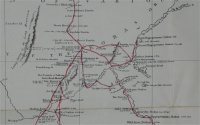 quarter of the nineteenth century, and
embracing a description of a large part of the Cape Colony and Bechuanaland at
this period."
quarter of the nineteenth century, and
embracing a description of a large part of the Cape Colony and Bechuanaland at
this period."
The key part of the large fold out map of Burchell's travels, the Klaarwater (or later Griquatown) region, can be seen in detail by clicking on the thumbnail on the right.
The Balson Holdings Family Trust holds copies of these two reprint books in perfect condition (1953 and 1967 reprints).
Critical comment on this work:A classic work sought after by book collectors. |
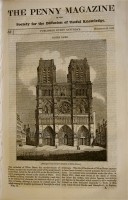 The Penny Farthing
- Weekly UK Magazine
The Penny Farthing
- Weekly UK Magazine
Eight pages, clear and sharp with beautiful detail.
The Magazine contains:
|
ENGRAVINGS (see below):
|
ARTICLES:
|
The Penny Magazine, published every Saturday, was aimed at the working class. It was part of the Society for the Diffusion of Useful Knowledge's program for liberal reform. for its reader, however, it was a source of information on subjects of general interest: everyday things like tea and coffee, well-known places in England, a series on animals and birds of Britain, descriptions of present-day manufacturing, even an American alaman and a serial of a personal account of an immigrant's problems. Poetry was published, too, and there are several illustrations in each issue.
The article about the Hottentots in the magazine draws largely from Barrow's , Le Vaillant's and Dr Philips' books
Here is an extract, a poem in the article about the plight of the Hottentot people:
Mild, melancholy and sedate he stands,
Tending another's flock upon the fields,
His father's once, where now the whiteman builds
His home, and issues forth his proud commands.
His dark eye flashes not; his listless hands
Lean on the shephard's staff; no more he wields
The Libyan bow - bit to the oppressor yields
Submissively his freedom and his lands.
Has he no courage? - once he had - but lo!
Hard servitude hath worn him to the bone.
No enterprise? - alas! the brand, the blow,
Have humbled him to dust - ev'n hope is gone,
"He's a hard hearted hound - not worth his food" -
His master cries - "he has no gratitude!"
The Balson Holdings Family Trust holds a copy of this magazine in the excellent condition.
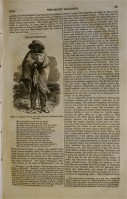 |
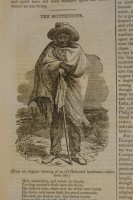 |
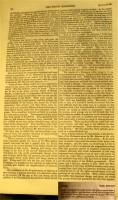 |
Critical comment on this work:Fascinating article on the Hottentots drawn from the observations of the early explorers and missionaries - Philips, Le Vaillant and Barrow. |
 Narrative of a Journey to the Zoolu Country, in South
Africa - Captain Allen F. Gardiner
Narrative of a Journey to the Zoolu Country, in South
Africa - Captain Allen F. Gardiner
8vo; modern quarter bound synthetic leather, with gilt-on-black cloth title labels on spine; new endpapers; pp. iv + 412; 26 plates, including some coloured; 2 folding maps. Pastedowns a little rippled; moderate foxing throughout, which is more severe in a number of plates; most tissue-guards either absent or fragmented; one of the maps is partially torn along the folds. The flyleaf has a near-contemporary ownership inscription of "Henry Owen", a relative of Rev. Francis Owen, whom Gardiner persuaded to serve as a missionary to the Zulus, and who was present at the time of Retief's murder.
There is an interesting description of the country, and it would appear that the military system and the deep-rooted belief in witchcraft prevailing among the inhabitants were great stumbling blocks to the conversion of the natives to religion or civilisation, and no great results were achieved by the missionaries, a fact corroborated by many other authors. … The volume contains some coloured portraits of Dingaan, many illustrations, two maps, the regulations of the town of Durban, and the treaty with the King of Zululand.
The Balson Holdings Family Trust holds a copy of this book in the excellent condition described above (value over US$500).
Critical comment on this work:Fascinating work with excellent historical ties through its early ownership. |
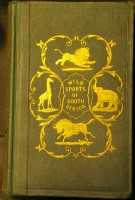 Wild Sports of Southern Africa - Captain William Cornwallis Harris
Wild Sports of Southern Africa - Captain William Cornwallis Harris  The first edition of this
work was published in 1838 with the title "Narrative of an expedition into
southern Africa", but it had only one illustration and a map. This is the second
edition published by John Murray.
The first edition of this
work was published in 1838 with the title "Narrative of an expedition into
southern Africa", but it had only one illustration and a map. This is the second
edition published by John Murray.
The book has eight plates and a map (see below).
This 387 page book is in its original covers.
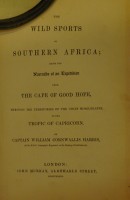 |
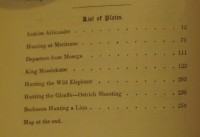 |
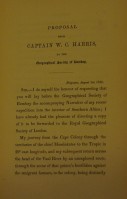 |
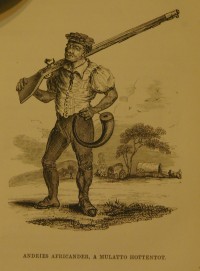 |
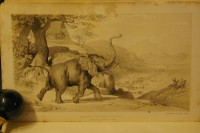 |
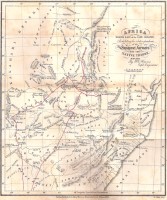 |
The Balson Holdings Family Trust holds a copy of this book in the excellent condition described above (value over US$2,500) (also holds two copies of the 1852 edition).
Critical comment on this work:One of the greatest 19th century works on African game and a true canon title of the genre. |
 Harpers Discovery in Africa - Professor Jameson
Harpers Discovery in Africa - Professor Jameson Narrative of Discovery and Adventure in Africa, From the Earliest Ages to the Present Time: With Illustrations of the Geology, Mineralogy, and Zoology. With a Map; Plans of the Routes of Park, and Of Denham and Clapperton; and Several Engravings.
Narrative of Discovery and Adventure in Africa, From the Earliest Ages to the Present Time: With Illustrations of the Geology, Mineralogy, and Zoology. With a Map; Plans of the Routes of Park, and Of Denham and Clapperton; and Several Engravings.
New York: Harper & Brothers, c.1840; 359 pages - Number 16 in Family Library.
By Professor Jameson, James Wilson, and Hugh Murray.
Period cloth binding, spine gilt lettered. Large engraved folding map as frontis. Numerous wood engraved illustrations. Publishers 6 pp. catalogue at rear.
In VG condition, gently worn, light minor spine end chipping, textblock lightly foxed but overall clean, tight & sound book. 19th century small local lending library bookplate to pastedown, traces of early paper label to spine, no other markings seen within.
Measures 4 1/8 x 6 1/4 inhes
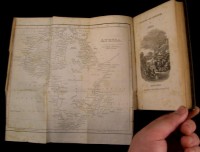 |
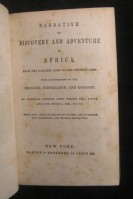 |
 |
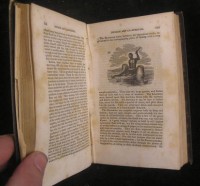 |
The Balson Holdings Family Trust holds a copy of this book in very good condition.
Critical comment on this work:An interesting work on early South Africa. |
 Wild Sports of Southern
Africa - Captain William Cornwallis Harris
Wild Sports of Southern
Africa - Captain William Cornwallis Harris  The first edition of this
work was published in 1838 with the title "Narrative of an expedition into
southern Africa", but it had only one illustration and a map; the second
edition (John Murray, 1839) contained only 8 plates. This is the very rare third edition.
The first edition of this
work was published in 1838 with the title "Narrative of an expedition into
southern Africa", but it had only one illustration and a map; the second
edition (John Murray, 1839) contained only 8 plates. This is the very rare third edition.
| In this book Harris reflects his total disgust in
the Hottentots he came across continuously referring to them as
drunk and, on page 286, summing up his feelings thus:
(The boer settlers in the eastern Cape) long subjected to the pilferings of a host of Hottentot vagabonds, whose lives are passed in one perpetual round of idleness, delinquency, and brutish intoxication on the threshold of the gin-shop.... |
This 359 page book has been rebound in new covers.
 |
 |
 |
The Balson Holdings Family Trust holds a copy of this book in the excellent condition described above and (value over US$2,500) (also holds two copies of the 1852 edition).
Critical comment on this work:One of the greatest 19th century works on African game and a true canon title of the genre. |
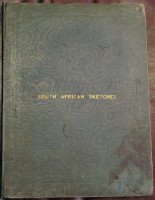 South African Sketches (1841)
South African Sketches (1841)  The first and only edition of this exceedingly rare illustrated hard covered book.
The first and only edition of this exceedingly rare illustrated hard covered book.
The book has just 15 pages of text describing the rugged lifestyle of the Cape frontier on its eastern borders at the Kat River and beyond (total about 50 pages with illustrations and dividers). Butler describes his hunting experiences in dramatic fashion while the fifteen hand-coloured prints and fifteen uncoloured prints at the back of the book add a great sense of class and value to this sought after book. (Some of the hand coloured images are displayed below)
This copy has a few minor tears on some of the text pages but the illustrations, apart from minor foxing on a couple of pages, are in excellent condition.
The A3-sized book is bound in the original dark green hard covers - as seen on the right.
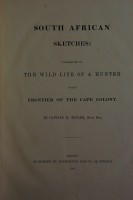 |
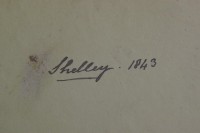 |
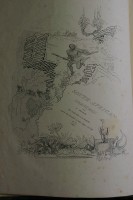 |
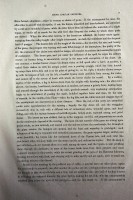 |
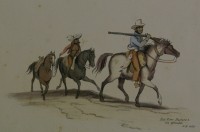 |
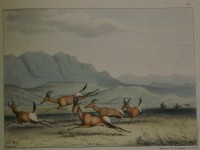 |
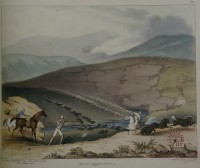 |
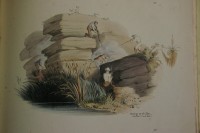 |
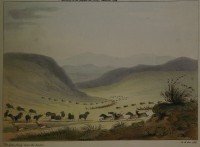 |
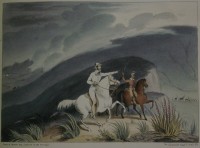 |
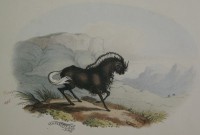 |
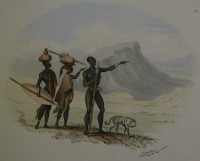 |
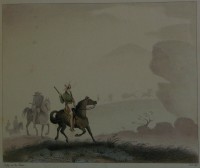 |
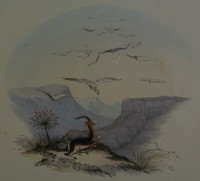 |
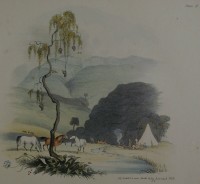 |
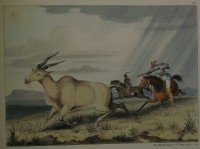 |
The Balson Holdings Family Trust holds a copy of this book in the excellent condition described above (value about US$2,500)
Critical comment on this work:While Butler's descriptions are dramatic it is the hand coloured plates that make this such a sought after work. |
 A
Narrative of a Visit to the Mauritius and South Africa - James
Backhouse
A
Narrative of a Visit to the Mauritius and South Africa - James
Backhouse 648 + lvi pages appendix,
frontispiece View of Table Bay - an etching from a drawing by Thomas Bowler is
shown below.
648 + lvi pages appendix,
frontispiece View of Table Bay - an etching from a drawing by Thomas Bowler is
shown below.
The book (re-covered) contains two folding maps - the large folding map at the end has Backhouse's journeys indicated in it and 16 etched plates and 28 woodcuts in the text, full calf, black title label on the spine, marbled edges and endpapers, light foxing on the title page, otherwise the contents are bright, overall a very good copy.
The book is in the form of a diary and the author seems to have traversed every part of South Africa where there was a mission station or a missionary. In this way he appears to have met every prominent man connected with mission work in South Africa at this time. From June 1838 to December 1840 the author was constantly travelling, visiting almost every inhabited town and district, carefully noting every point of interest in the country and its inhabitants. There is a good description of Kaffraria and of the Basutos, Griquas and Bechuana countries. There is also a narrative of a journey to Great Namaqualand.
The Balson Holdings Family Trust holds a copy of this book in the excellent condition described above (value over US$500).
Critical comment on this work:One of the greatest 19th century works by one of the region's earliest travellers. |

Captain Frederick Marryat (1792-1848) was an English novelist, a contemporary and acquaintance of Charles Dickens, noted today as an early pioneer of the sea story. He is now known particularly for the semi-autobiographical novel Mr Midshipman Easy (1836) and his children's novel The Children of the New Forest (1847). After trying to run away to sea several times, he was permitted to enter the Royal Navy in 1806, as a midshipman on board HMS Imperieuse. In 1829 he was commanding the frigate HMS Ariadne on a mission to search for shoals around the Madeira and Canary Islands. This was an uninspiring exercise, and between that and the recent publication of his first novel, The Naval Officer (1829) he decided to resign his commission and take up writing full time.
A very interesting 200 page hard copy novel (measuring 16cm by 11cm) aimed at the youth.
In this rare first edition of the book he talks of and extraordinary adventure after his ship sinks off the east coast of South Africa. His journeys take him all over the region and includes life among the Griqua - Andries Waterboer, their Kaptyn and, of course, the rebel Africaner. Much of his information has been gleaned from Robert Moffat's work.
There have been many recent reprints of the book whilst this original edition cannot be found for sale on the Internet.
The contents and two volumes.. there are a few plates scattered through the book
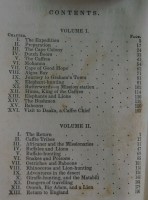
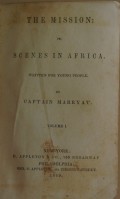
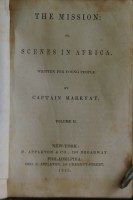
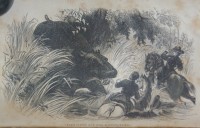
The Balson Holdings Family Trust holds a copy of this book in good condition.
Critical comment on this work:A fascinating work by one of the region's earliest travellers. |
 297 pages and four black and white
plates. Substantial wear on the spine but the book is sound and complete. The
book has been inscribed by William Winthrop who was the United States Consul at
Malta in the 1860s. The second book held is also in poor condition with the
covers separated - it was once owned by the Boston Library - see image
right.
297 pages and four black and white
plates. Substantial wear on the spine but the book is sound and complete. The
book has been inscribed by William Winthrop who was the United States Consul at
Malta in the 1860s. The second book held is also in poor condition with the
covers separated - it was once owned by the Boston Library - see image
right.
Charles Bunbury accompanied his friend, Sir George Napier, the Governor of the Cape Colony, on his voyage to Africa in 1837, and remained there for fourteen months, during which time he busied himself with botanical research, travelling over a considerable part of South Africa. In the course of his journeys he had ample opportunity of observing the political state of the country, and refers to the necessity for a firm and consistent policy. He refers to the Great Trek of the Boers which was still proceeding, and enters into the reasons for this step."
A fascinating view of contemporary South Africa through the eyes of a British traveller. As well as discussing Cape Town and its history, his journey into the country takes him to Port Elizabeth and Graham's Town, which he covers in travel notes, as well as in his botanical studies. The book also includes separate chapters on botany, including mention of the wealth of plant species on top of Table Mountain. A couple of species are reproduced in the engraved plates. This is a rare volume on South Africa, its history and contemporary politics and conflict.
Some of the plates
in this rare first edition book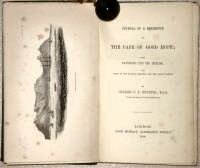
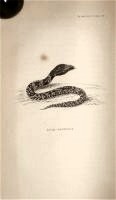
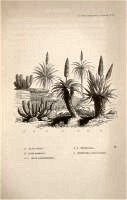
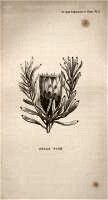
The Balson Holdings
Family Trust holds two copies of this book in poor condition as described
above
(value over US$500).
Critical comment on this work:A fascinating work by one of the region's earliest travellers. |

 A Hunter's Life in South Africa -
A Hunter's Life in South Africa - Roualeyn George Gordon-Cumming, (1820- 1866), Scottish traveller and sportsman, known famously as the "Lion Hunter". From his early years he was distinguished by his passion for sport, and chased lion, elephant, hippopotamus, giraffe, rhinocerous and other South African wild game. Cumming was famous for hunting in his kilt; he had earlier served in Madras Light Cavalry and had vast experience hunting throughout India as well as in the American West and in Scotland. He came to South Africa chiefly because of its opportunities for sport and travel, in 1843, and he served in the Cape Rifleman. During his stay in the East he had laid the foundation of his collection of hunting trophies and specimens of natural history. In 1843 he joined the Cape Mounted Rifles, but for the sake of absolute freedom sold out at the end of the year and with an ox wagon and a few native followers set out for the interior. He hunted chiefly in Bechuanaland and the valley of the Limpopo River, regions then swarming with big game.
This extremely rare two volume books on Cumming's adventures in 1844 - 1845, shown right, diarises his hunting trips through Central South Africa. There is a chapter (7) dedicated to the Griqua at Philippolis and Rhama. More at this link.
A very nice set of one of the great early classics of African hunting and adventure. He traveled widely and shot enormous numbers of Big Game, eventually procuring enough impressive trophies to open his own "South African Museum" in London. These books are vividly written, as they were based on Cumming's daily journals, written up every evening; and they capture the excitement, dangers and uncertainties of travel, hunting and military campaigns. He was among the first Europeans to explore some areas of southern Africa, and this remains one of the most important description of its inhabitants in the years before colonialism.
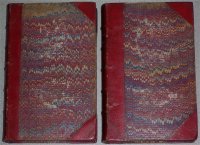 Cumming
starts as follows, "As the reader who purposes to follow me through the five
adventurous years I spent in the untrodden wilds of Southern Africa might like
to know something of my previous career, I shall briefly state that the early
portion of my life was spent in the county of Moray, where a love of natural
history and of sport early engendered itself, and become stronger and more
deeply rooted with my years. Salmon-fishing and roe-stalking were my favourite
amusements; and, during these early wanderings by wood and stream, the strong
love and most attractive forms became with me an all-absorbing feeling, and my
greatest possible enjoyment was to pass whole days and many a summer night in
solitude, where, undisturbed, I might contemplate the silent grandeur of the
forest and the ever-varying beauty of the scenes around. Long before I proceeded
to Eton I took pride in the goodly array of hunting trophies which hung around
my room......"
Cumming
starts as follows, "As the reader who purposes to follow me through the five
adventurous years I spent in the untrodden wilds of Southern Africa might like
to know something of my previous career, I shall briefly state that the early
portion of my life was spent in the county of Moray, where a love of natural
history and of sport early engendered itself, and become stronger and more
deeply rooted with my years. Salmon-fishing and roe-stalking were my favourite
amusements; and, during these early wanderings by wood and stream, the strong
love and most attractive forms became with me an all-absorbing feeling, and my
greatest possible enjoyment was to pass whole days and many a summer night in
solitude, where, undisturbed, I might contemplate the silent grandeur of the
forest and the ever-varying beauty of the scenes around. Long before I proceeded
to Eton I took pride in the goodly array of hunting trophies which hung around
my room......"
Interestingly Cumming still refers to the "Griquas" at Philippolis as being called "Bastards" under Adam Kok while he referred to them as being known as Griquas under Waterboer at Griquatown. He is very clear on this - stating that they were once united but had now split into the two groups and named accordingly.
Cumming met and stayed with the famous missionaries Robert Moffat (at Kuruman) and Dr David Livingstone (at Mabotsa) - Livingstone had earlier married Moffat's eldest daughter in 1844.
Livingstone, in Chapter 7 of his book "Missionary Travels" refers to his meeting with Cumming in the heart of Africa:
JANUARY 28TH. Passing on to Letloche, about twenty miles beyond the Bamangwato, we found a fine supply of water. This is a point of so much interest in that country that the first question we ask of passers by is, “Have you had water?” the first inquiry a native puts to a fellow-countryman is, “Where is the rain?” and, though they are by no means an untruthful nation, the answer generally is, “I don’t know — there is none — we are killed with hunger and by the sun.” If news is asked for, they commence with, “There is no news: I heard some lies only,” and then tell all they know.
This spot was Mr. Gordon Cumming’s furthest station north. Our house at Kolobeng having been quite in the hunting-country, rhinoceros and buffaloes several times rushed past, and I was able to shoot the latter twice from our own door. We were favored by visits from this famous hunter during each of the five years of his warfare with wild animals. Many English gentlemen following the same pursuits paid their guides and assistants so punctually that in making arrangements for them we had to be careful that four did not go where two only were wanted: they knew so well that an Englishman would pay that they depended implicitly on his word of honor, and not only would they go and hunt for five or six months in the north, enduring all the hardships of that trying mode of life, with little else but meat of game to subsist on, but they willingly went seven hundred or eight hundred miles to Graham’s Town, receiving for wages only a musket worth fifteen shillings.
No one ever deceived them except one man; and as I believed that he was afflicted with a slight degree of the insanity of greediness, I upheld the honor of the English name by paying his debts. As the guides of Mr. Cumming were furnished through my influence, and usually got some strict charges as to their behavior before parting, looking upon me in the light of a father, they always came to give me an account of their service, and told most of those hunting adventures which have since been given to the world, before we had the pleasure of hearing our friend relate them himself by our own fireside. I had thus a tolerably good opportunity of testing their accuracy, and I have no hesitation in saying that for those who love that sort of thing Mr. Cumming’s book conveys a truthful idea of South African hunting. Some things in it require explanation, but the numbers of animals said to have been met with and killed are by no means improbable, considering the amount of large game then in the country. Two other gentlemen hunting in the same region destroyed in one season no fewer than seventy-eight rhinoceroses alone. Sportsmen, however, would not now find an equal number, for as guns are introduced among the tribes all these fine animals melt away like snow in spring. In the more remote districts, where fire-arms have not yet been introduced, with the single exception of the rhinoceros, the game is to be found in numbers much greater than Mr. Cumming ever saw. The tsetse is, however, an insuperable barrier to hunting with horses there, and Europeans can do nothing on foot. The step of the elephant when charging the hunter, though apparently not quick, is so long that the pace equals the speed of a good horse at a canter. A young sportsman, no matter how great among pheasants, foxes, and hounds, would do well to pause before resolving to brave fever for the excitement of risking such a terrific charge; the scream or trumpeting of this enormous brute when infuriated is more like what the shriek of a French steam-whistle would be to a man standing on the dangerous part of a rail-road than any other earthly sound: a horse unused to it will sometimes stand shivering instead of taking his rider out of danger. It has happened often that the poor animal’s legs do their duty so badly that he falls and causes his rider to be trodden into a mummy; or, losing his presence of mind, the rider may allow the horse to dash under a tree and crack his cranium against a branch. As one charge from an elephant has made embryo Nimrods bid a final adieu to the chase, incipient Gordon Cummings might try their nerves by standing on railways till the engines were within a few yards of them. Hunting elephants on foot would be not less dangerous,21 unless the Ceylon mode of killing them by one shot could be followed: it has never been tried in Africa.
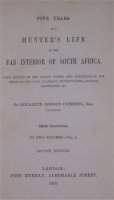 |
This set of two books is
extremely rare and cannot be found for sale on the Internet
The Balson Holdings Family Trust holds a copy of this first edition book (as well as the later editions) in very good condition.
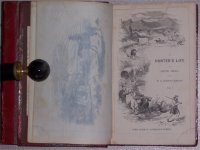 |
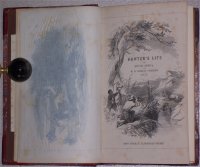 |
Critical comment on this work:An easy to read and well written book which gives an interesting insight into the life and adventures of Gordon Cumming who had an Eton education and who was the second son of Sir William Gordon Cumming, 2nd baronet of Altyre and Gordonstown, Elginshire . |
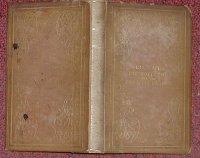 The Kafir, the
Hottentot, and the frontier farmer - Archdeacon Merriman
The Kafir, the
Hottentot, and the frontier farmer - Archdeacon MerrimanPpii + 216, black and white and 3 coloured illustrations, folding map, mustard blind-stamped cloth with gilt lettering.
The book, Merriman's 1850 diary, was published by the Bishop of Cape Town after Merriman's death.
It records in diary form the background to the Kat River rebellion by the Hottentots.
Merriman describes the Griquas of Griquatown and Philippolis on page 84 as being unable "to keep a shop; not from any deficiency or mathematical or inability to keep the books , but from the impossibility which they find in preventing their countrymen from getting into debt, or making them pay debts when they have contracted them. In fact, there is an universal prevelance of social dishonesty among them, and almost as universal a prevelance of the questionable quality of a "good nature", so called, that they cannot say "no" to a begging idler or fellow countryman."
 |
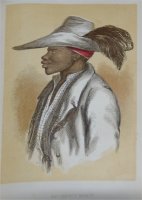 |
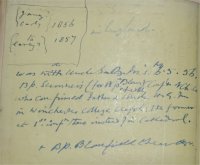 |
|
The Map of South Africa |
A Hottentot Man |
Inscription at end of book |
Two copies of this rare book in excellent condition are held by the Balson Holdings Family Trust.
Critical comment on this work:Fascinating first hand account of the lives of the Griquas |
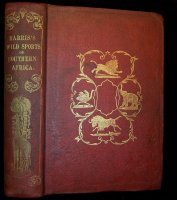
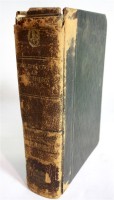 Wild Sports of Southern Africa - Captain
William Cornwallis Harris
Wild Sports of Southern Africa - Captain
William Cornwallis Harris  The first edition of this work was
published in 1838 with the title "Narrative of an expedition into southern Africa",
but it had only one illustration and a map; the second edition (John Murray,
1839) contained only 8 plates. This enlarged fifth edition is the most valuable
and desirable version, as it is lavishly illustrated with 26 full-page
lithographic handcoloured plates, including a folding map and 359 pages. One of the
handcoloured plates in the book can be seen below right.
The Balson Holdings Family Trust has two copies of this book.
The first edition of this work was
published in 1838 with the title "Narrative of an expedition into southern Africa",
but it had only one illustration and a map; the second edition (John Murray,
1839) contained only 8 plates. This enlarged fifth edition is the most valuable
and desirable version, as it is lavishly illustrated with 26 full-page
lithographic handcoloured plates, including a folding map and 359 pages. One of the
handcoloured plates in the book can be seen below right.
The Balson Holdings Family Trust has two copies of this book.
Tall royal 8vo, publisher’s original red cloth, upper cover with ornate border in blind and decorated with a central motif featuring four African animals, lower cover with border in blind, spine lettered and decorated in gilt featuring a large gilt giraffe, a.e.g.
This is the best edition and very rare; one copy in its original gilt decorated cloth. Harris’ study goes far beyond simple game hunting and is a valuable look into the Africa of the day. In addition to the studies of the wildlife, he also gives us through both the text and the lithographic plates a look at some of the indigenous peoples of the region. The plates themselves are highly noteworthy. The images are dynamic and capture the movements, the very nuances, of the subjects. In many cases these were among the earliest glimpses Western peoples experienced of these fascinating animals and peoples. The colour reproduction is excellent and the plates in both copies are particularly clean and bright.
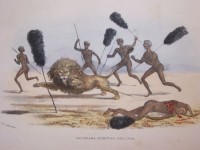
The red bound book above has been skillfully and unobtrusively recased preserving the original cloth on the spine. An uncommonly well preserved copy with none of the expected foxing and only very minor age mellowing or wear to the scarce original cloth, particularly to the bottom corners.
and
Second copy ex-Library with Library treatments. There is one with no stamp on the front. Leather spine is chipped and missing about an inch, boards are worn and scuffed. Hinges are cracked but binding is secure and Pages are clean but delicate.
The Balson Holdings Family
Trust holds two copies of this book in the excellent condition described above
(value over US$1,500) as well as the 1841 and 1839 edition.
Critical comment on this work:One of the greatest 19th century works on African game and a true canon title of the genre. |

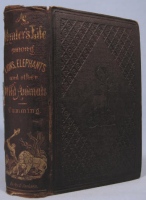 A Hunter's Life in South Africa -
A Hunter's Life in South Africa - Extremely rare later editions
The Balson Holdings Family Trust owns copies of the extremely rare 303 page 1856 and 1858 print of Cumming's adventures in 1844 - 1845, shown right, diarises his hunting trips through Central South Africa. There is a chapter (7) dedicated to the Griqua at Philippolis and Rhama. More at this link. The editions with an identical cover to that seen right (1856 frontispiece at this link) has hand coloured images in the front of the book - like those shown below from the earlier 1855 edition.
This more common 1855 edition (New York) has the same images (see below) and text but is larger in size and had beautiful coloured edges to the pages when initially printed. These are now faded but can still be seen.
Considering all these books are in very good condition. Although cloth bound the books above have the look of leather because of the dark chocolate covers, the deckled finish and deeply embossed front and back; The spine is engraved with gold gilt titles and lion attacking two men; There are eight time period full page woodcut illustrations of hunting scenes (see below). There is some wear, has corner, edge and spine rubs, front and back cloth tears at meeting of spine and boards (even still the original boards are holding very well). Binding is good and still pretty firm, strengthened inside hinges with flexible cloth adhesive repair. Pages are mostly clean but has normal foxing for a book of its age, all pages are account for and are fully attached, although the front two have a short partial tear.
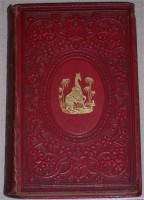 Perhaps
the greatest value of this book is Cumming's lengthy and detailed descriptions
including that of grasslands literally swarming with springbok, kudu, gemsbok
and wildebeest. His book is blamed as being the trigger for a raft of white
hunters who followed - wanting to experience the awesome sight of massive herds
of buck. He also describes in great detail the structure and make up of the
typical "beehive" shaped Griqua house and its portability...
Perhaps
the greatest value of this book is Cumming's lengthy and detailed descriptions
including that of grasslands literally swarming with springbok, kudu, gemsbok
and wildebeest. His book is blamed as being the trigger for a raft of white
hunters who followed - wanting to experience the awesome sight of massive herds
of buck. He also describes in great detail the structure and make up of the
typical "beehive" shaped Griqua house and its portability...
Image right: The more common 1855 edition of the book
Interestingly Cumming still refers to the "Griquas" at Philippolis as being called "Bastards" under Adam Kok while he referred to them as being known as Griquas under Waterboer at Griquatown. He is very clear on this - stating that they were once united but had now split into the two groups and named accordingly.
Cumming met and stayed with the famous missionaries Robert Moffat (at Kuruman) and Dr David Livingstone (at Mabotsa) - Livingstone had earlier married Moffat's eldest daughter in 1844.
This early edition of the book is extremely rare and cannot be found for sale on the Internet
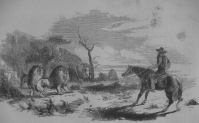 |
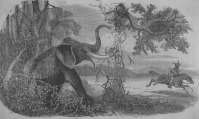 |
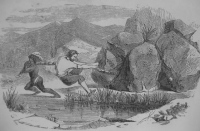 |
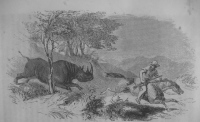 |
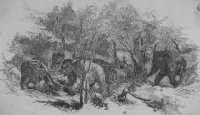 |
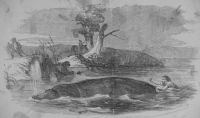 |
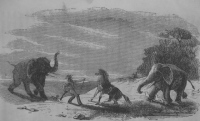 |
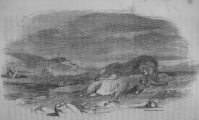 |
The Balson Holdings Family Trust holds a copy of these books (as well as the more common 1856 edition and rare 1850 first edition) in very good condition. A second copy of the 1858 edition was once in the library of Colorado County Colorado Superintendent of Schools(1884), Henry Champlin Lay. More about Lay at this link.
Critical comment on this work:An easy to read and well written book which gives an interesting insight into the life and adventures of Gordon Cumming who had an Eton education and who was the second son of Sir William Gordon Cumming, 2nd baronet of Altyre and Gordonstown, Elginshire . |
 Zulu Land, life among the
Zulu-Kafirs - Rev Lewis Grout
Zulu Land, life among the
Zulu-Kafirs - Rev Lewis Grout  Zulu-Land or Life among the
Zulu-Kafirs of Natal and Zulu-land, South Africa is a thorough and comprehensive
book written by Rev. Lewis Grout, a missionary for fifteen years among the Zulus
from 1847-1862. The author obtained an intimate knowledge of the history,
customs and social like of the natives, and the laws and government of the
country.
Zulu-Land or Life among the
Zulu-Kafirs of Natal and Zulu-land, South Africa is a thorough and comprehensive
book written by Rev. Lewis Grout, a missionary for fifteen years among the Zulus
from 1847-1862. The author obtained an intimate knowledge of the history,
customs and social like of the natives, and the laws and government of the
country.
Lewis Grout, ordained and married on the same day, set sail with his new bride two days later for South Africa, reaching the District of Natal in February, 1847. For the next fifteen years he labored among the Zulus, pursuing his missionary efforts and studying the native languages. He authored "Grammar of the Zulu Language" which was first published in 1859 in Natal. This work was described as one of the best of the early grammatical works on the Zulu language.
The revised version of this book is sold for over US$600. Grout also translated the Bible and other works into the Zulu language.
This fascinating book of Zulu-Kafirs and their homeland
begins with the authors first experience in Africa and the necessity of learning
quickly how to "outspan 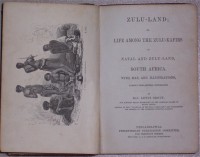 for the night."
Chapters include:
for the night."
Chapters include:
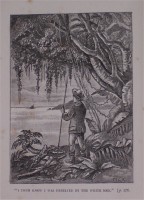 |
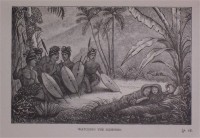 |
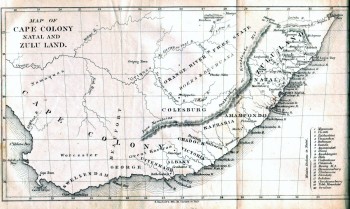 |
The Balson Holdings Family Trust holds a copy of this first edition book in excellent condition - in original binding.
Critical comment on this work:A classic work on the Zulus sought after by book collectors. |
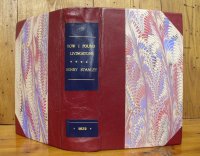 How I found Livingstone: Travels, Adventures and
Discoveries in Central Africa
How I found Livingstone: Travels, Adventures and
Discoveries in Central Africa  Includes an Account of four
Month's Residence with Dr. Livingstone,
Includes an Account of four
Month's Residence with Dr. Livingstone,
This 736 page book with six maps is valued at about US$400. The book has been recently rebound in Three Quarter burgundy leather with marbled boards, and marbled endpapers.
It is in this book that the immortal words "Dr Livingstone, I presume" reflect Stanley's introduction to Africa's greatest explorer. Stanley describes in this book how he and Livingstone went to the source of the Nile - Lake Tanganyika and re-wrote the earlier findings by Burton.
The Balson Holdings Family Trust holds two copies of this first edition book in excellent condition - one in original binding.
Critical comment on this work:A classic work sought after by book collectors. |
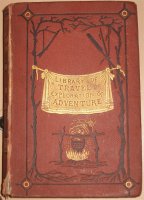 Library of Travel Exploration and Adventure, S Africa
- Bayard Taylor
Library of Travel Exploration and Adventure, S Africa
- Bayard Taylor
1872 first edition
 Scribner, Armstrong & Co., New
York, 1872. 12mo, 7.5 x 5 inches, 336 + 6 pp. publisher's advertisements +
preliminaries which include a fold-out map. The book, part of a series by
Taylor, cannot be found for sale on the Internet. Includes 23
illustrations. Hardcover, red-brown cloth / faux-leather, gold stamped &
black lettering and illustrative bricabrac on front cover and spine. One of the
first volumes of the "Illustrated Library of Travel, Exploration and Adventure."
A "bound by the Riverside Press" sticker is found on the rear endpaper assuring
that this is indeed the original binding, as it was printed by Houghton at
Riverside Cambridge.
Scribner, Armstrong & Co., New
York, 1872. 12mo, 7.5 x 5 inches, 336 + 6 pp. publisher's advertisements +
preliminaries which include a fold-out map. The book, part of a series by
Taylor, cannot be found for sale on the Internet. Includes 23
illustrations. Hardcover, red-brown cloth / faux-leather, gold stamped &
black lettering and illustrative bricabrac on front cover and spine. One of the
first volumes of the "Illustrated Library of Travel, Exploration and Adventure."
A "bound by the Riverside Press" sticker is found on the rear endpaper assuring
that this is indeed the original binding, as it was printed by Houghton at
Riverside Cambridge.
The discovery and settlement of South Africa, focusing on the journeys of Anderson, Livingstone, and Magyar.
Mild soiling and edgewear, bumped corners, one section toward the center starting to come loose, and likewise the spine. With a little bindery attention this could be a very nice addition to your library. A former owners name (W. or N. Johnston) is penciled on the dark-blue front free endpaper, and another's stamp is on the first blank page, "I.N. Taylor," a descendant of the book's compiler through celebrated Stanford biologist C.V. Taylor.
The book has several illustrations - some of which are shown below - of most interest is the one of a Hottentot playing a musical instrument.
The book is factually unsound in several places. For example Griquatown is referred to as "Griqua City" with a population of some 20,000 - even today the population is nowhere near that number and would have numbered well under one thousand at that time!
Two copies of this extremely rare first edition copy held by the Balson Holdings Family Trust - both are in fair condition.
|
The frontal graphic |
Dr Livingstone |
The frontispiece |
|
Interesting map |
Hippos |
Natives dancing to the moon |
|
Dr Livingstone attacked by a lion |
The Basuto King Moshesh |
A Hottentot musician |
Critical comment on this work:Part of a series of books on early travel by Bayard Taylor - factually questionable. |

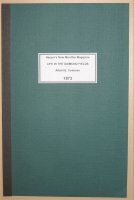 The author of this very rare 15 page
report in the American publication Harpers New Monthly
Magazine was a first-hand witness to brutal torture and punishment of
diamond field slaves in the Orange Free State. Tolerant to this practice, he
also berates, judges and compares the character and work ethic of African
tribes, including the Zulu, Basutos, Hottentots, Griqua and Korana. He imparts
an enlightening and shocking 19th century account which resonates with today's
allegations of global corruption and exploitation in the diamond mining
industry!
The author of this very rare 15 page
report in the American publication Harpers New Monthly
Magazine was a first-hand witness to brutal torture and punishment of
diamond field slaves in the Orange Free State. Tolerant to this practice, he
also berates, judges and compares the character and work ethic of African
tribes, including the Zulu, Basutos, Hottentots, Griqua and Korana. He imparts
an enlightening and shocking 19th century account which resonates with today's
allegations of global corruption and exploitation in the diamond mining
industry!
The report has been rebound in soft green boards as seen right.
The Balson Holdings Family Trust also holds the complete, bound and extremely rare, Harpers Volume XLVI....December 1872 to May 1873 magazines which includes this article. (See images below).
A few plates from the article can be seen below - the report includes a map of the region including Griquatown at this link. This map clearly shows the disputed boundary marked at David's Grave on the Modder River.
The Balson Holdings Family Trust holds a copy of this article and Harpers Volume XLVI - both carefully bound and in excellent condition.
Critical comment on this work:A fascinating but disturbing first hand insight onto the cruelty of the mine owners. |
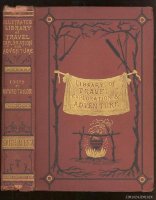 Illustrated Library of Travel Exploration and
Adventure (1873)
Illustrated Library of Travel Exploration and
Adventure (1873)
Book in transit (July 2007)
Bayard Taylor transcribed the comments of explorers around this world
This very rare book covers Africa
Three plates and one map from the book can be seen below.
The Balson Holdings Family Trust holds a copy of this article carefully bound in excellent condition.
Critical comment on this work:Yet to be reviewed |
 Materials for a speech in defence of abandoning
Materials for a speech in defence of abandoning
the Orange River Territory - Sir William Molesworth
1854 (reprinted 1878)
 In 1878, when Mr. J. P. S. Kruger and Mr.
Joubert came to England to protest against the
English annexation of the Transvaal, they asked
and obtained permission from Sir William Molesworth's widow to republish the "Materials for a speech
in defence of the policy of abandoning the Orange
River Territory," which had originally been published in May 1854 following the historic recognition
of Sir Harry Smith of the boer state. The British handed over the Orange Free State Territory to the Boers on the 23rd February 1854.
Sir William Molesworth was an influential member of the British Parliament and this speech was the foundation behind the decision to desert the Griqua.
In 1878, when Mr. J. P. S. Kruger and Mr.
Joubert came to England to protest against the
English annexation of the Transvaal, they asked
and obtained permission from Sir William Molesworth's widow to republish the "Materials for a speech
in defence of the policy of abandoning the Orange
River Territory," which had originally been published in May 1854 following the historic recognition
of Sir Harry Smith of the boer state. The British handed over the Orange Free State Territory to the Boers on the 23rd February 1854.
Sir William Molesworth was an influential member of the British Parliament and this speech was the foundation behind the decision to desert the Griqua.
This move to reprint Molesworth speech was an act of desperation by Kruger and Joubert who carried 6,500 boer signatures with them to London demanding the British recognise their independence. Two years later the boers rose against the British at Paardekraal, near Krugersdorp, with Joubert and Kruger at their head. The Boers quickly defeated the smaller British force.
This copy of the reprinted book comes from the library of the Transvaal Independence Committee making it historically significant (see scans below).
Of course the discovery of gold and diamonds changed the earlier British point of view given by Molesworth and led to the Boer war in 1899. It was the influence of Sir William Molesworth that led to the British selling the Griqua out to the Boers and when you see scans of relevant pages below you can see how his speech discarded the Griqua landowners as nothing more than thieves and bandits.
The duplicity and self-serving motives of the British colonial power could never be more clearly demonstrated than in this speech. For example, among the comments below, he suggests that the highly religious Andreas (sic) Waterboer the Kaptyn at Griquatown was a vagabon Hottentot. (He was actually a San/Bushman and, as a result, despised by the Griqua). He goes on to describe the Griqua thus "a mongrel breed between the Dutch and Hottentot" who plundered the frontier farmers.
It was this sort of misinformation by Molesworth that saw Sir Harry Smith getting his way when he discarded the Griqua in exchange for a secure border north of the Orange River.
This is how Sir Harry Smith earlier portrayed the Griqua to his sister in a letter in 1851:
"My dearest Alice,
I wish I was half the active fellow now I was then, for I have need of it, seeing I am Her Majesty's Despotic Bashaw, from Cape Point to Delagoa Bay to the east, and to the great newly discovered lake to the north-west–without a legislature, and in the midst of a war with cruel and treacherous and ungrateful savages and renegade and revolted Hottentots. These Hottentots have been treated as the most favoured people, enjoying all the rights, civil and religious, of the inhabitants at large of the Colony–fed as a population when starving,–yet have these ungrateful wretches in great numbers (not all) revolted and joined their hereditary and oppressive enemy the Kafir, who drove them from the Kye over the Fish River, and who have destroyed them as a nation.
I have had so much to do and some little anxiety of mind, although I sleep like a dormouse, that I have not written lately to one so dear to me, but Juana has. The war-making Kafirs are cowed by the continued exertions among them of my numerous and vigorous patrols, but they are in that state of doggedness they will neither come in nor fight. By every communication I have open to me, I offer peace to the people, but the Chiefs must await my decision, their conduct has been so treacherous, cunning, and deceitful. I have succeeded in maintaining in peace and tranquillity nearly one-half of the population of British Kaffraria, those fortunately next to the sea, while the Gaika Kafirs, natives of the mountains adjoining the Hottentot great location of the Kat Province, are all at war. This shows my system cannot be oppressive, or I should have had no friendly Kafirs, whereas the latter escort my waggons with supplies, slaughter cattle, carry my mails, assist me in every way in their power, which affords better argument in refutation of the Radical and garbled untruths, though founded on facts, of Sir W. Molesworth. I will give you an example [of one] among other accusations of my despotism. The Kafir Hermanus, who by birth is a Negro slave, was ever heretofore with his people an enemy to the Kafir, because it was his interest to be friendly to us. After the war of 1835-6, Sir B. D'Urban gave him a grant of a beautiful tract of country within the Colony upon the ever-supplying-water, the Blinkwater, stream. His title was disputed by some of the colonists, and it was complained that he paid no quitrent as they all did. It was just, and only just, that if he was protected by the government, he should contribute, equally with others, his quota for its maintenance. I therefore, as a part of a general system, exacted a quitrent, a mere trifle, which was the best possible title and deed of occupation, yet does this throating Sir W. M. Bring forward this as an act of despotism. It is really ludicrous.
But for this inexplicable Hottentot revolution, I would have put down the Kafirs in six weeks. These Hottentots are the most favoured race on earth, yet have a set of Radical London Society missionaries been preaching to them like evil spirits that they were an oppressed and ill-used race, until, encouraged by violent meetings all over the Colony upon the convict question, they have met with arms in their hands, arms given to them by us, for the purpose of joining the Kafirs to drive the English over the Zwartkop River beyond Uitenhage.
I have endeavoured to administer this government so as to allow the all-powerful sun to shine forth its glory upon all its inhabitants, whether black or white, equally, and I have no other object than the welfare of the people generally. I have said, 'Lay before me your wants; they shall be considered and your wishes met if practicable.' This was appreciated until the d— convict question arose. The emancipated blacks in Cape Town, the Hottentots in the Kat River, held anti-convict meetings got up by white Radicals, who have thus induced the coloured classes upon this frontier and in many other parts of the Colony to believe that separate interests exist for white and black.
The Kafir has been fostered by the most benevolent acts of kindness by me as a Governor. My study has been to ameliorate their condition from brutes to Christians, from savages to civilized men. They progressed in three years beyond all belief until some white-faced devils (the sable king often wears a white face) got in among them, persuaded the chiefs my object was their extermination, and while the people clung with avidity to my protection from the former tyranny they groaned under, the chiefs asserted their feudal authority, and such is man in a wild state of nature, he cleaves to the hereditary rule of oppressors of his forefathers–with tears in his eyes. I have seen many weep when they came to say to me farewell; 'Our country will be lost.' Let Sir W. M. and his myrmidons deny this; he cannot, but he can assert that just measures are foul, despotic, and arbitrary acts.
Juana is in better spirits now since the reinforcements have arrived, I hope. Since I have received the dear Duke's kind letter, Juana regards me as supported by old friends and present master.205 The latter gentleman and I understand each other. I will be censured by no man, but I will endeavour to obey where I can. He affronted me by finding fault with an 'abortive attempt to reform the Legislative Council,' which made my blood boil, although my remonstrance was as mild as milk. I think the recent attempt he and his colleagues have made to form a government has been fully as abortive as mine, and they have discovered the impossibility of making legislators of men who will not undertake office. Since the outbreak all his communications have been most complimentary.
Your brother
HARRY.
P.S.–I have been urged by many friends to send home some one to support the cause of my government. I won't. It is a weak line of conduct to appeal to friendship when conduct is in intention free from imputation of evil. Let Miss Coutts peruse this if she can. You had better copy it in your legible hand, for the enormous quantity I write has as much impaired my autograph as hard roads the fore-legs of a trotting horse, if England still produces one. That she does asses, I know."
A copy of this extremely rare document of Sir Molesworth's speech, in very good condition, is held by the Balson Holdings Family Trust.
|
The frontispiece |
Transvaal Independence Committee |
Kruger/Joubert Intro |
|
Key pages of the speech |
||
Critical comment on this work:An irreplaceable piece of South African history. |
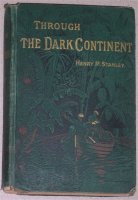 Through the Dark Continent - Henry M Stanley -
1879
Through the Dark Continent - Henry M Stanley -
1879  This 500 plus page book with a
large fold out map covers Stanley's second trip to Africa (in 1872). The book is
in its original binding and generally in excellent condition - though the map
has separated at the folds..
This 500 plus page book with a
large fold out map covers Stanley's second trip to Africa (in 1872). The book is
in its original binding and generally in excellent condition - though the map
has separated at the folds..
The Balson Holdings Family Trust holds a copy of this book in very good condition
Critical comment on this work:A classic work sought after by book collectors. |
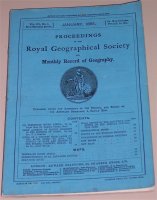
 A substantial paper in the Royal
Geographic Society bulletin written on the urge to follow the lead indicated by
Livingstone in his first journey of exploration and further explore the
temperate region of South Africa.
A substantial paper in the Royal
Geographic Society bulletin written on the urge to follow the lead indicated by
Livingstone in his first journey of exploration and further explore the
temperate region of South Africa.
Sir Henry Bartle Edward Frere, 1815-84, was a British colonial administrator. He served from 1850-59, as chief commissioner of Sind, distinguishing himself during the Indian Mutiny, and was governor of Bombay from 1862-67. In 1872 he negotiated a treaty with the sultan of Zanzibar for the suppression of the slave trade. Appointed governor of Cape Colony and high commissioner of British South Africa, Frere had to cope with Boer discontent in the newly annexed Transvaal, the conflict between the Griquas and the boers and with Zulu unrest in Natal. Intent on breaking the military power of the Zulus, he precipitated in 1878 the Zulu War. His action was disapproved in London, and although he was popular in the Cape he was recalled to England in 1880. Just before his recall he signed this document giving title of land to a Charles Brisley, a partner in the firm Strachan and Company.
In this lengthy article Frere calls on the Royal Geographic Society to lobby the authorities to survey the coastline of South Africa correctly as it was not up to the standards required for "modern" shipping. He also details the role of the various missionary societies in educating the various peoples of Southern Africa.
This rare original copy of the January 1881 edition of the Royal Geographic Society's monthly record is held by the Balson Holdings Family Trust.
Critical comment on this work:A fascinating account of South Africa at this time - includes estimated population figures of native tribes and the geographic area that they inhabited. Frere fell out with powerful figures in Britain and was recalled and "fired". The Balson Holdings Family Trust holds a number of extremely rare Royal Geographic Society papers including: Sir Bartle Frere's obituary, 1884; a paper on a trip "from Cape Town to Nyassa" (with maps) 1886 and Ptolemy's topography of Eastern Equatorial Africa, 1891 with original maps. |
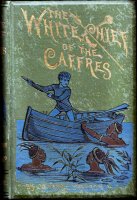
 An extremely rare and hard to find
315 page book by Major-General Alfred W. Drayson, author of "Sporting Scenes Amongst the Kaffirs of South Africa."
A young boy, Julius Peterson, was shipwrecked on the south-east coast of
Africa near the Umzimvubu river south of Natal which flows through the
region later occupied by the Griquas. Drayson and other shipwrecked white people
encountered the Caffres (Pondo or Amapondo natives - an off-shoot of the Zulus
to the north).
An extremely rare and hard to find
315 page book by Major-General Alfred W. Drayson, author of "Sporting Scenes Amongst the Kaffirs of South Africa."
A young boy, Julius Peterson, was shipwrecked on the south-east coast of
Africa near the Umzimvubu river south of Natal which flows through the
region later occupied by the Griquas. Drayson and other shipwrecked white people
encountered the Caffres (Pondo or Amapondo natives - an off-shoot of the Zulus
to the north).
As a young 10 year old boy he survived a Caffre attack shortly after the ship wreck in which all the other men were killed, and he was allowed to live and be brought up as a member of their tribe. Intriguing account of survival, bravery, becoming a chief, hunting all the wild game of Africa, fighting Zulus, being captured, narrow escapes, encounters with Bushmen and Boers. The "opera glasses" which brought things near and the gun which dispersed the Bushmen brought the young Drayson great esteem among the Pondo people long before the first whites settled what was later to become East Griqualand.
Although a story Drayson's book parallels what actually did happen in that region in the 1700s - with whites shipwrecked on the coast at Umzimvubu being taken into the local Amapondo tribe and coloured children resulting from the union of white women and their native captors. The book gives an excellent account of the region and how the harbour at Durban looked before being settled by the white man.
The book has a deep green cloth bevelled hardback with pictorial cover with bright gilt title. Spine is also decorated with Zulu warrior and bright gilt title. Tissue-guarded frontispiece and numerous wonderful illustrations throughout. This rare book is in very good to excellent condition, with clean pages, no writing, end papers have some foxing, a little wear to cover print.
This rare first edition 1887 edition of this book is held by the Balson Holdings Family Trust.
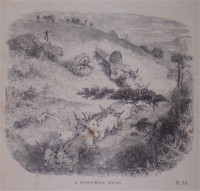 |
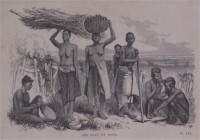 |
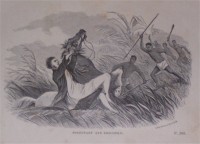 |
Critical comment on this work:An extremely rare novel which gives a graphic insight into a young white man's earliest contact with the Amapondo and Zulu people in the region of southern Natal/East Griqualand. Easy reading and well told. |
 The first edition of a very
reliable account of an expedition to Damaraland and Ovampoland (now part of
Namibia), 1850-1852. The author was fortunate in finding so experienced a
traveller as C J Anderson to accompany him.
The first edition of a very
reliable account of an expedition to Damaraland and Ovampoland (now part of
Namibia), 1850-1852. The author was fortunate in finding so experienced a
traveller as C J Anderson to accompany him.
The book was published by the Minerva Library of Famous Books - with several of its other works advertised at the back.
There are some fascinating descriptions of life in Africa at this time - as can be seen in the extract copied from the book below. Galton worked mainly among the Namaquas in the arid north-western regions, and travelled to South West Africa.
The book has a map (seen below) and several illustrations - the history of Damaraland is updated in this third edition.
This is a very rare find - especially in this condition.
|
The book is |
The map |
Frontispiece |
|
Illustrations in the book |
The Balson Holdings Family Trust holds this book in pristine condition.
Critical comment on this work:An interesting work covering an area north of South Africa that many Hottentots fled to in the 1700s. |
 The book covers Stanley's (a
reporter) travels through north and east Africa with Zanzibar as his base. The
book discusses the extraordinary trials of Stanley's party as they traversed
"Darkest Africa". Of 373 souls 57 were sick and 16 died half way through his
travels (pg 192 vol one)!
The book covers Stanley's (a
reporter) travels through north and east Africa with Zanzibar as his base. The
book discusses the extraordinary trials of Stanley's party as they traversed
"Darkest Africa". Of 373 souls 57 were sick and 16 died half way through his
travels (pg 192 vol one)!
The impact of Stanley's African exploration can be seen by the two images below - the first taken in 1886 the second in 1890.
The book is profusely illustrated with two maps in pockets at the end of each volume.
This is a very rare find - especially in this condition.
| The two volumes in pristine condition |
Stanley in the front of volume one |
Stanley in the front of volume two |
The Balson Holdings Family Trust holds a rare matching pair of these two volumes in pristine condition.
Critical comment on this work:A classic work with great descriptions and detail of some very exploration of "Darkest Africa". |
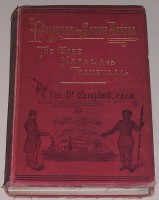 Rambles in South
Africa - Rev Dr John Kerr Campbell 1891
Rambles in South
Africa - Rev Dr John Kerr Campbell 1891 The book covers Campbell's travels (holiday) through much of South Africa from Durban, Natal to Post Elizabeth, Johannesburg and Cape Town. It gives n interesting insight into the lifestyle lived by the settlers and the African tribes that he met on his travels.
The book can be acquired quite easily through the Internet.
The Balson Holdings Family Trust holds a copy of this book.
Critical comment on this work:An easy to read book which gives an interesting insight into the times. |
 This insightful book into the very
early days of Natal and Nomansland (early 1800s). Chas Brownlee was in charge of
Native Affairs and had an intimate understanding of the various tribes including
the Kaffirs, Fingos, Griquas, Pondos and Zulu. He describes how the Zulus under
the warring Chaka cleared a large tract of land of humanity, subsequently named
Nomansland, where the Griquas then settled in 1861.
This insightful book into the very
early days of Natal and Nomansland (early 1800s). Chas Brownlee was in charge of
Native Affairs and had an intimate understanding of the various tribes including
the Kaffirs, Fingos, Griquas, Pondos and Zulu. He describes how the Zulus under
the warring Chaka cleared a large tract of land of humanity, subsequently named
Nomansland, where the Griquas then settled in 1861.
This second edition of the 1896 book, written by W T Brownlee (Chas' son), was printed in 1916 and includes valuable research material not included in the first. The material covers the early history of Natal and East Griqualand, superstitions and customs among the native races, biographical sketches on some prominent Africans and addresses b Brownlee to Mission Stations.
A valuable reference work.
The Balson Holdings Family Trust holds two copies of this book as displayed below.
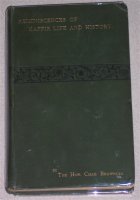 |
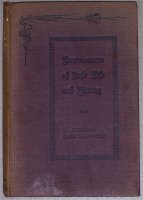 |
|
The 1896 first edition |
The edited 1916 reprint |
Critical comment on this work:An excellent book (nearly 400 pages long) which details the very early history of Natal and East Griqualand. A must for the serious researcher. |

 Interesting 430pg hardcovered book
with several images and maps. It is part of a series by Bent.
Interesting 430pg hardcovered book
with several images and maps. It is part of a series by Bent.
Bent makes the early history easy reading and covers the fascinating Zimbabwe ruins.
The Balson Holdings Family
Trust holds a copy of this book in very good condition.
More images
from the book below.
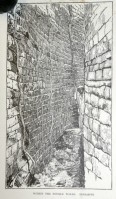 |
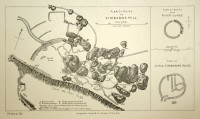 |
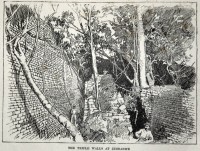 |
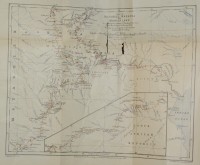 |
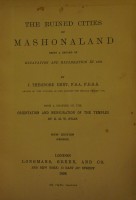 |
|
|
|
|
Critical comment on this work:An excellent book (over 400 pages long) covering Bent's research on the area just north of the Griqua. |